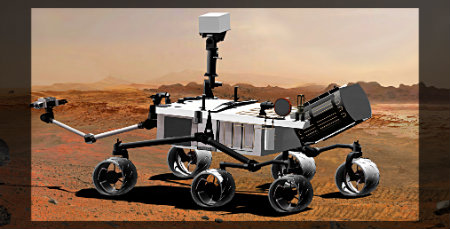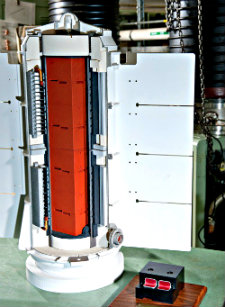Via About Robots
-----

The nuclear battery is the black 'tail'
Photo courtesy of NASA
First, I'll tell you its real name: NASA calls it the Multi-Mission Radioisotope Thermoelectric Generator, or MMRTG.
And the principle is quite simple: the radioactive plutonium generates
heat by splitting naturally into more stable atoms. The heat is used to
'cook' a thermocouple that generates electricity to the whole system.
Okay, so just like you, my next question was: what is a thermocouple?
When you make 2 different metals touch each other, it creates a tension
(voltage) that is dependant on the temperature. It is very reliable to
calculate the tension from the temperature if you use the right metals.
Now, if you want to make a battery, you just need to have 2 junctions at
2 different temperatures. You can get more info from
Wikipedia's page on thermocouple.
That's it: the Plutonium generates very regular heat over several years,
the heat hits up the warm part of the thermocouple, and the
thermocouple generates electricity to the system.
The whole system
is safe enough and small enough that even if the rocket explodes at
launch, the Plutonium would most likely not be released, and it's
release wouldn't even be a problem.
Has it been used before?
Look inside nuclear battery
Photo courtesy of NASA
 |
Yes
it has! It has been used since the Apollo mission. The first time I
heard about the Curiosity Rover nuclear battery, I was thinking this
must be top notch technology. What a surprised I had when I saw it has
been used for more that 40 years already. It's never too late to learn
how it works anyway.
Let's quote NASA: "The Apollo missions to the
moon, the Viking missions to Mars, and the Pioneer, Voyager, Ulysses,
Galileo, Cassini and New Horizons missions to the outer solar system all
used radioisotope thermoelectric generators."
Still, the
Curiosity Rover nuclear battery is a new generation battery that is used
for the first time on this Mars rover. As NASA says, it is more
flexible and can be used on a wide variety of missions since they have
better control over the tension delivered by the new system.
In
particular, only the new generation can deliver 14 years of energy
within a 45kg, 60X60X60cm box. Yes, it is not much different from the
boiler in your house, but so much more powerful.
Let's compare to Solar Panels
Why didn't they send the Mars Science Laboratory with solar panels like the 2 previous generations of Mars rovers?
In
short, NASA wanted to make this mission better and faster. The 2 main
drawbacks of solar panels is that they don't work during the night, and
they don't work during the Martian winter. One consequence is that the
Mars Exploration Rovers couldn't work for more that half of the time.
The Curiosity rover is bigger, needs more power
Photo courtesy of NASA
 |
The
Curiosity Rover Nuclear Battery will supply the system with constant
power, allowing it to work as much as needed, all year long for as long
as 14 years. Imagine the difference when the rover is traveling from one
point to another if it doesn't have to stop every night.
Another
thing is that the new rover is much bigger and holds more experimental
tools, and can go a little faster. All in all, the power supply from the
nuclear battery is nearly 3 times more than the solar panels (in day
time).
All these are clear good reasons for the Mars Science Laboratory to go to Mars with some Plutonium in its backpack.



